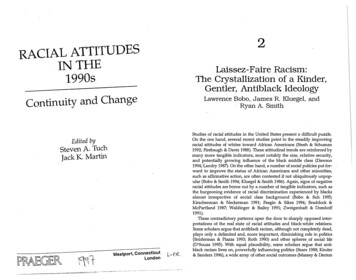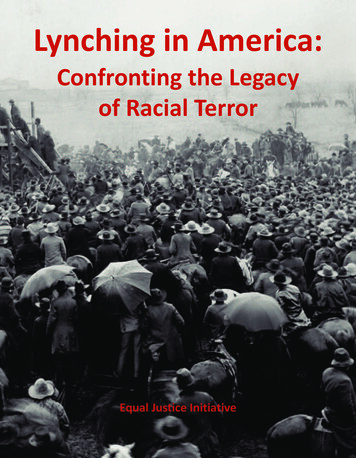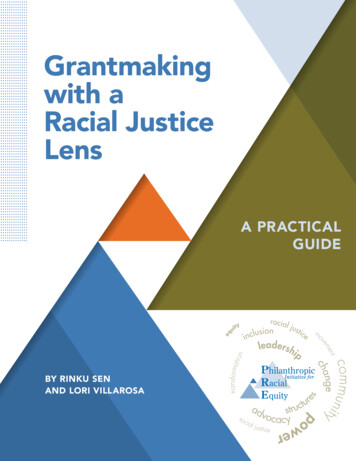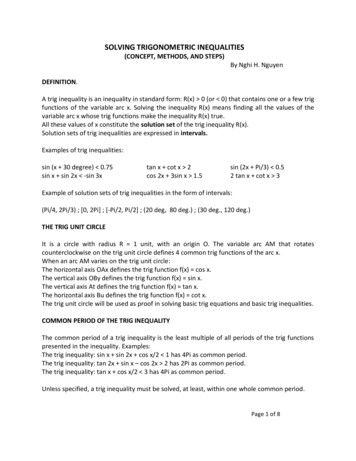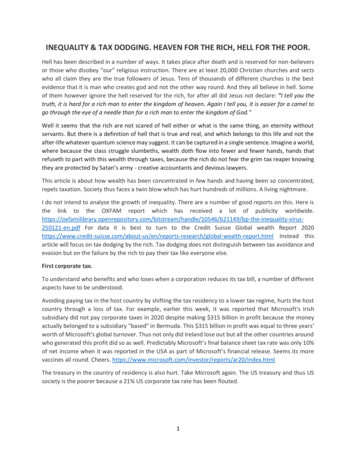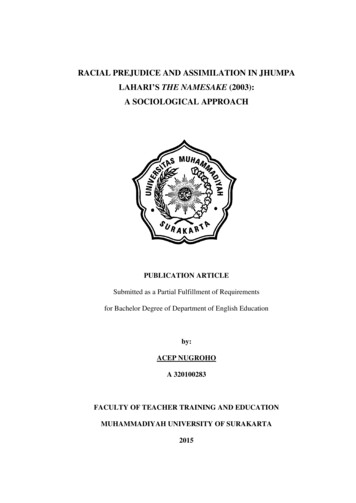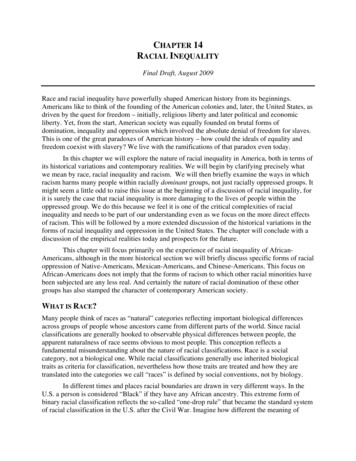
Transcription
CHAPTER 14RACIAL INEQUALITYFinal Draft, August 2009Race and racial inequality have powerfully shaped American history from its beginnings.Americans like to think of the founding of the American colonies and, later, the United States, asdriven by the quest for freedom – initially, religious liberty and later political and economicliberty. Yet, from the start, American society was equally founded on brutal forms ofdomination, inequality and oppression which involved the absolute denial of freedom for slaves.This is one of the great paradoxes of American history – how could the ideals of equality andfreedom coexist with slavery? We live with the ramifications of that paradox even today.In this chapter we will explore the nature of racial inequality in America, both in terms ofits historical variations and contemporary realities. We will begin by clarifying precisely whatwe mean by race, racial inequality and racism. We will then briefly examine the ways in whichracism harms many people within racially dominant groups, not just racially oppressed groups. Itmight seem a little odd to raise this issue at the beginning of a discussion of racial inequality, forit is surely the case that racial inequality is more damaging to the lives of people within theoppressed group. We do this because we feel it is one of the critical complexities of racialinequality and needs to be part of our understanding even as we focus on the more direct effectsof racism. This will be followed by a more extended discussion of the historical variations in theforms of racial inequality and oppression in the United States. The chapter will conclude with adiscussion of the empirical realities today and prospects for the future.This chapter will focus primarily on the experience of racial inequality of AfricanAmericans, although in the more historical section we will briefly discuss specific forms of racialoppression of Native-Americans, Mexican-Americans, and Chinese-Americans. This focus onAfrican-Americans does not imply that the forms of racism to which other racial minorities havebeen subjected are any less real. And certainly the nature of racial domination of these othergroups has also stamped the character of contemporary American society.WHAT IS RACE?Many people think of races as “natural” categories reflecting important biological differencesacross groups of people whose ancestors came from different parts of the world. Since racialclassifications are generally hooked to observable physical differences between people, theapparent naturalness of race seems obvious to most people. This conception reflects afundamental misunderstanding about the nature of racial classifications. Race is a socialcategory, not a biological one. While racial classifications generally use inherited biologicaltraits as criteria for classification, nevertheless how those traits are treated and how they aretranslated into the categories we call “races” is defined by social conventions, not by biology.In different times and places racial boundaries are drawn in very different ways. In theU.S. a person is considered “Black” if they have any African ancestry. This extreme form ofbinary racial classification reflects the so-called “one-drop rule” that became the standard systemof racial classification in the U.S. after the Civil War. Imagine how different the meaning of
Chapter 14. Racial Inequality2“race” would be in the US if the one-drop rule were reversed: anyone with any Europeanancestry would be classified as white. In Brazil, in contrast to the U.S., racial classifications areorganized on a more continuous spectrum. In the U.S. all East Asians are considered a singleracial category; in East Asia, on the other hand, Chinese, Japanese, Koreans and Vietnamese areconsidered separate races. The United States Immigration Commission in 1911 consideredpeople of Irish, Italian, Polish, and English descent to be distinct “races”, and the 1924Immigration Act passed by Congress restricted immigration of what were termed “inferior races”from Southern and Eastern Europe. In Germany under the Nazis, Jews were considered a distinctrace, not merely a religious group or an ethnic group. In Africa today, Tutsi and Hutu havesometimes been regarded as distinct races. Racial classifications are thus never simply given bybiological descent even if they always invoke biology; they are always constructed throughcomplex historical and cultural processes.Racial classifications do not logically imply racial oppression (i.e. a social injusticebacked by power). This is how ethnic distinctions are sometimes experienced: to be of Irish orSwedish or Italian descent in America is to share a certain cultural identity, and perhaps toparticipate in certain cultural practices as well, but this does not imply any forms of oppressioninvolving these categories. Ethnic difference can be just that: differences. Racial classificationscould in principle be simply a way of noting physical differences of various sorts that are linkedto biological descent. However, in practice racial classifications are almost always linked toforms of unjust economic and social inequality, domination, and exclusion, as well as to beliefsystems that assign superior and inferior statuses and attributes according to race. Indeed, as asociological generalization we can say that racial classifications become salient in people’s livesprimarily to the extent that they are linked to forms of socioeconomic inequality and oppression.1The term “racism” designates this intersection of racial classification with oppression.2RACISM AND THE LIVES OF WHITE AMERICANSTo study race in American society, then, is to investigate the ways in which racial classificationsare linked to historically variable forms of oppression. The moral core of such an analysis isunderstanding the ways in which racial oppression imposes harms on people in the raciallyoppressed category. Nevertheless it is a mistake to think of racism as something that only affectsthe lives of African Americans, Native Americans, Asian Americans, Latinos and other raciallydefined “minorities”. Racism has profoundly shaped American society and politics in ways thatdeeply affect the lives of white Americans as well, particularly the lives of working class andpoor whites, not just the lives of minorities.Racism harms disadvantaged groups within the white population in two principle ways.First, racism has repeatedly divided popular social and political movements, undermining theircapacity to challenge prevailing forms of power and inequality. Ruling elites have often usedrace as part of a strategy of “divide and conquer” to protect their class interests. Numerous1Once a racial category becomes historically rooted and part of the daily lives of people it can also become anethnicity – a category of people with shared historical experience, cultural practices and identities. This adds to thecomplexity of race as a form of social division.2The word “racism” is sometimes used more narrowly to refer simply to beliefs and ideologies that have a racistcontent. We will use the term in a more encompassing way to include both the social relations and the systems ofbelief that link forms of socioeconomic injustice to racial classifications.
Chapter 14. Racial Inequality3examples can be cited: In the 1880s and 1890s a radical political movement of workers and small farmers – thePopulists – emerged in the Midwest and the South. For a time it appeared that blacktenant farmers and small white farmers in the South might be able to make commoncause against large landowners and Southern elites. At its height the Populists appearedto pose a potentially serious challenge to the dominant political parties of the period andeven to the interests of dominant classes. Racial conflict eventually tore apart the agrarianunity of the Populists and contributed to the decline of the movement overall. Throughout the late 19th century and the first part of the twentieth century employersused racial minorities as strike breakers in industrial strikes. This significantly weakenedthe ability of unions to win strikes, and also contributed to deep resentments againstblacks and other minorities within the white working class. In the late 1960s and early 1970s, in response to the civil rights movement, theRepublican Party under Nixon adopted what came to be known as the “SouthernStrategy” in which racial fears were deliberately used to get white working class voters toswitch political allegiance from the Democrats to the Republicans. This strategy iscredited by many scholars with ushering in an era of conservative politics whichultimately significantly harmed the economic interests of white workers by weakeningunions, lowering the minimum wage, reducing job security. Research on wage inequality has demonstrated that in those cities and regions of theUnited States where the black/white wage difference is the greatest it is also the case thatthe wages of white workers are the lowest and inequality among whites is greatest.3 Whatthis suggests is that racial divisions within the working class weaken the ability ofworkers as a whole to bargain higher wages with their employers. White workers, in thelong run, would be better off economically if there was less inequality and moresolidarity between white and black workers.In the absence of racial divisions and racial conflict, popular social forces would in general havebeen stronger, more capable of influencing political parties and challenging dominant classinterests.The second way that racism has negatively affected the interests of less advantagedsegments of the white population is through the ways it has undermined universalistic aspects ofthe welfare state. Universal programs are programs that apply to all people. They are contrastedwith targeted programs that apply only to special, designated groups. In general, as we noted inour discussion of poverty, universalistic programs tend to be better funded than targetedprograms and to more robustly improve the conditions of life of people at the bottom of the classstructure. In the critical period in which the American welfare state was initially created – theNew Deal in the 1930s – there was strong opposition by Southern Democrats to universalisticpolicies because of the ways such policies would benefit Black Americans as well as WhiteAmericans. In spite of the widespread poverty in the South, the Democrats in the South wereextremely conservative on social welfare issues and effectively blocked the possibility of3See Michael Reich, Racial Inequality: A Political-Economic Analysis, Princeton University Press, 1981
Chapter 14. Racial Inequality4national universalistic programs because of racism. For example, in the legislation that set thebasic framework for labor law and the rights of unions they insisted that provisions be includedwhich would effectively exclude most black labor from union rights, and social security initiallyexcluded domestic workers and agricultural labor for the same reasons. Universal healthinsurance was off the table at least in part because of opposition to universalism. While many ofthe exclusions of the New Deal have since been eliminated, they nevertheless helped create atype of welfare state averse to the kind of universal programs that we see in most developedcapitalist democracies. Racism played an important role in this. This has harmed the interests ofthe majority of whites.THE HISTORICAL TRAJECTORY OF RACIAL OPPRESSIONWhile racism may harm significant segments of the racially dominant group in Americansociety, nevertheless racism is above all a form of domination that harms the racially oppressedgroups. These harms have been a core part of American history, and not merely of distanthistory. It is hard to overstate this point: it is only in the most recent past that the classical liberalidea of equality before the law has been extended to include racial minorities, and even today inmany critical respects such equality remains more promise than reality.In this section we will explore historical variations in the distinctive forms that racialoppression has taken in the United States. This will, of necessity, be a highly simplified andstripped down historical account. Its purpose is to help give specificity to the current problem ofracial inequality in American Society by seeing what has changed and what remains. We willfocus on the five primary forms of racial oppression that have occurred in United States history:genocide and geographical displacement; slavery; second-class citizenship; non-citizen labor;diffuse racial discrimination. These constitute an overlapping historical sequence, with differentracially defined groups being the subjects of different forms of racism in different historicalperiods.1. Genocide and geographical displacementWhen European settlers came to North America they encountered an indigenous population thathad effective control over the most important economic resource of the time: land. From veryearly on, displacement and genocide were the central ways of dealing with the inevitableconflicts over this resource, first by the British colonies and later by the U.S. Government. The19th century folk saying “the only good Indian is a dead Indian” reflects the moral monstrosity ofthis stance. Most often the land was simply confiscated by force and the indigenous inhabitantsdriven off or killed. Occasionally land was formally ceded by Native American tribes throughtreaties in the aftermath of military defeat. When treaties occurred, they guaranteed the nativepeople making the treaty certain rights in exchange for the agreement. Often these rights weresubsequently ignored.Such displacements were claimed to be justified on the grounds that the native peoplewere uncivilized “savages” and did not really “own” the land since they were often nomadic orsemi-nomadic without permanent settlements and permanent cultivation of particular pieces ofland. But even in instances where Native Americans were agriculturalists and did have suchsettlements there was little hesitation in forcibly evicting them from the land. The removal of theCherokee Nation from the Southeastern United States by Andrew Jackson in the 1830s is thebest known instance. The Cherokees had deliberately adopted a policy of assimilation into
Chapter 14. Racial Inequality5American ways of life, living in settled communities, practicing extensive farming, and evenowning slaves. In spite of this, white settlers coveted their lands, and Andrew Jackson used themilitary power of the Federal Government to force the Cherokees – and the other NativeAmerican peoples of the Southeast – to move west of the Mississippi.By the end of the 19th century this displacement was complete and Native Americanswere largely confined to bounded geographical spaces called Indian Reservations. The preciselegal standing of these reservations has varied over time, but generally they have been accordedsemi-sovereign status with at least some rights of self-government. In the 21st century NativeAmericans are no longer required to live on Indian Reservations. They are now full Americancitizens and can move freely about the country. Nevertheless, the lives of many NativeAmericans are still deeply marked by the legacy of the severe forms of racial oppression andgeographical isolation to which they were historically subjected. As a group, they areeconomically among the most deprived segment of the American population, particularly whenthey live on Indian Reservations.2. Slavery.Everyone knows that most people with African ancestors living in the United States today are thedescendants of people who were the property of white Americans. Everyone knows this, but it iseasy to lose site of what this really means. Human beings were property: they were owned in thesame sense as a horse can be owned. They could be whipped and branded and in other waysphysically harmed with virtually no legal restrictions. The killing of a slave by a slave masterwas almost never punished. The rape of slaves was a common practice. Slave owners were freeto split up families and to sell the children of slaves.The fact that slave owners had absolute power over their slaves, of course, does not meanthat all slave masters ruthlessly abused their slaves. Many slave owners accepted a paternalisticideology in which slaves were regarded as children for whom they had moral responsibility, andcertainly some slave owners tried to live up to that ideal. More importantly, slave owners werebusinesspeople for whom slaves were an important investment, and the value of that investmentneeded protection. Just as farmers have an incentive to be sure that their horses are well fed andnot overworked to the point that their health and productivity is threatened, so slave owners hadincentives to take care of their investments in the bodies of their slaves. Particularly after theinternational slave trade was banned at the beginning of the 19th century and thus the price ofslaves increased, slave owners took measures to insure that the value of their investments did notdeteriorate. As a result, by the time of the Civil War the calories consumed and material standardof living of American slaves was not very different, and perhaps even a little higher, than that ofpoor peasants and unskilled workers in many parts of Europe.Some scholars have argued on the basis of these facts about improving standards of living ofslaves in the 19th century that slavery was not as oppressive as often thought.4 This claimminimizes the impact on the lives of slaves of the condition of such radical and completeunfreedom and the deep symbolic degradation that slaves experienced. The nature of the socialstructure of slavery meant that significant physical brutality was ubiquitous in spite of themodestly improving standard of living of slaves and the ideology of paternalism. Because4The best known defense of this view is by Robert Fogel and Stanley Engerman, Time on the Cross: The Economicsof American Negro Slavery (Second Edition). New York: W.W. Norton and Company, 1995.
Chapter 14. Racial Inequality6slavery was a lifetime condition, slaves had very little positive incentive to work hard. Since theprosperity of slave owners depended on the effort of their slaves, this meant that slave ownershad to rely very heavily on negative incentives – force and the threat of force – to extract sucheffort. As a slave owner in Arkansas stated, “Now, I speak what I know, when I say it is like‘casting pearls before swine' to try to persuade a negro to work. He must be made to work, andshould always be given to understand that if he fails to perform his duty he will be punished forit.”5 Even slave owners who sincerely believed in their paternalistic responsibilities to care fortheir slaves justified this harsh treatment on the grounds that the childlike nature of their blackslaves meant that force was the only thing that they understood.The pervasive domination and exploitation of slavery was accompanied by pervasive formsof resistance by slaves. The most common form of resistance occurred in the mundane activitiesof the slave plantation: poor work, occasional sabotage, passivity. Runaway slaves were achronic problem, and political conflict over how to deal with slaves who escaped to the Northwas one of the sources of tension that lead to the Civil War. Occasionally there were violentslave revolts, and while rare, this fueled an underlying fear of blacks among whites in the Southand contributed to the massively repressive and violent apparatus of the slave state.While slavery came to be restricted to the South in the course of the 19th century, it would bea mistake to see this form of racial oppression as exclusively affecting the South. The economyof the North was deeply linked to Southern slavery in the Colonial period, particularly throughthe notorious “triangular trade” in which Slaves were purchased in Africa with European goods,then sold in the Caribbean and North America and the profits used to ship Tobacco, rum andcotton back to Europe. Some have argued that the direct and indirect profits from this trade wasthe single most important source of capital accumulation in the colonies, including in NewEngland.6 At the time of the Constitutional Convention slaves were owned by northerners as wellas southerners, and many of the founding fathers were slave owners. In the early years after theRevolution, slavery was still legal in a number of Northern States. In New York there were still10,000 slaves in the 1820 census, and significant numbers of slaves were reported as late as the1840 census in New Jersey. Right up to the Civil War, the Northern economy continued to belinked to slavery through textile manufacturing. Even after slavery was outlawed in the NorthernStates beginning in the late 18th century, the North collaborated with the South in allowingescaped Slaves to be captured and returned to the South, particularly after the Dred Scottdecision of the U.S. Supreme Court.7 And while it was true that in the years leading up to theCivil War abolitionist sentiment grew steadily in the North, many people in the North wereperfectly content to let slavery continue in the South.By the time of the civil war, there were nearly four million slaves in the United States, about13% of the total US population. In the fifteen states in which slavery was legal, just over one in5Quoted by Kenneth Stamp, The Peculiar Institution: Slavery in the Ante-bellum South. New York: Knopf. 1975, p.1716See, for example, David Eltis, Economic Growth and the Ending of the Transatlantic Slave Trade. New York &Oxford: Oxford University Press, 1987.7In the Dred Scott Decision of 1856, the Supreme Court ruled that an escaped slave remained the property of theoriginal slave owner even if the slave managed to get to a state in which slavery was illegal, and thus it was legal forthe slave owner to recapture the slave.
Chapter 14. Racial Inequality7four white families were slave owners.8 This is a higher proportion than families who hiredmaids and servants in the non-slave states.9 In Mississippi the proportion of households thatowned slaves was 49%.10 While most of these Southern slave-owning families owned only a fewslaves, this meant that the direct experience of owning another person of a different race wasvery widespread in the South. For the white population in the antebellum South, the racialoppression of blacks was not simply something that was part of the social environment in whichthey lived; it was a significant part of the daily routines in which they were active participants.Slavery ended with the Civil War almost a century and a half ago, but of course its impactdid not disappear simply because this form of racialized class relations had been destroyed.Slavery contributed to a particularly pernicious and durable form of racist beliefs that continuesto influence American culture today. Slavery posed a deep cultural problem for the United Statesafter the American Revolution: How could a country founded on the principles of “life, libertyand the pursuit of happiness” accommodate slavery? How was it possible to reconcile thedevotion to liberty and democracy with the treatment of some people as the property of others?The solution to this deeply contradictory reality was the elaboration of racial ideologies ofdegradation and dehumanization of blacks as intellectually and morally inferior and thus notworthy of treatment as full persons. The attribution of intellectual inferiority meant that blackswere seen as lacking intellectual capacities for rational action, and thus, as in the case ofchildren, choices should be made on their behalf by responsible adults. The attribution of moralinferiority supported the view of blacks as inherently dangerous, ruled by passions, bothaggressive and sexual, and thus incapable of exercising liberty. These beliefs constituted the coreof the racist culture forged under slavery and although such beliefs were increasingly challengedin the last decades of the twentieth century and are no longer seen as respectable, they continueto influence race relations to the present.3. Second-Class citizenshipSlavery was abolished after the Civil War, but this did not mean a complete dismantling oflegally-enforced racial oppression. On paper, the 14th Amendment to the U.S. Constitution,ratified in 1868, guaranteed equal protection of the law and full rights to all citizens, and the 15thamendment passed two years later explicitly specified these rights applied to all peopleregardless of race or color. If these Amendments had been taken seriously and rigorouslyenforced, then racial oppression could not have taken the form of second-class citizenship.Second class citizenship refers to a situation in which some categories of citizens have fewer8According to Gavin Wright, a leading authority on slavery , “As of 1860, in the cotton-growing areasapproximately one half of the farms did not own slaves; for the South as a whole, the percentage of slaveowningfamilies declined from 36 in 1830 to 25 in 1860.” Gavin Wright, The Political Economy of the Cotton South. NewYork: Norton.9In the 1860 census, in the non-slave states, 506,366 people were classified as private household workers(housekeepers, laundresses, and other). The population of the nonslave states in 1860 was 19,410,197. Since, onaverage, households at that time consisted of about 5.3 people, this means that there were approximately 3,640,000households in the non-slave states in the United States in 1860. The maximum percentage of these households whichcould have employed a private household worker was 14%, if (implausibly) no household employed more than onesuch worker.10These figures come from 1860 census data reported on “the Civil War Home Page”, http://www.civilwar.net/pages/1860 census.html.
Chapter 14. Racial Inequality8rights than others. This can either take the form of an official, legally defined denial of somerights, or a less formal practical denial of rights. Laws which prohibit people who have beenconvicted of felonies from voting, for example, are an example of legally-defined second-classcitizenship that is still common in the United States today.11 Police practices which target certaingroups of people for stricter law enforcement or judicial practices which systematically imposestiffer sentences on particular categories of people would be examples of unofficial second classcitizenship. Public policies which treat some categories of citizens as more worthy of respectthan others can also be seen as creating a kind of second class citizenship. Margaret Somers hasargued that the public disrespect of poor African-Americans reflected in the abandonment of thepeople left behind in New Orleans during the Hurricane Katrina disaster in 2005 is a strikingexample of their denial of full recognition as equal citizens.12Official second-class citizenship became the pivotal form of racial oppression in the UnitedStates, especially in the South, in the decades following the Civil War. The emancipation ofslaves in the South posed a serious problem for large landowners who had previously reliedalmost entirely on slave labor for their incomes. Most slaves wanted to become small farmers,and there were moments in which the promise of “forty acres and mule” seemed to open thepossibility of former slaves becoming a yeoman class of independent farmers. In order for thisdream to have become a reality, however, widespread dispossession of large Southernlandowners of their land would have been necessary, and in spite of the Civil War, the FederalGovernment was loathe to violate the rights of private property owners to this extent. As a resultfew ex-slaves were in a position to acquire land.Large Southern landowners thus retained possession of the land, but they no longer ownedthe labor to work the land. In terms of the concept of class discussed in chapter 11, thelandowners effectively hoarded the economic opportunities represented by land, but they nolonger had complete control over a supply of labor to exploit. What was needed, then, was a newsystem to tie ex-slaves to the land and give planters effective control over their labor. In thedecades following the Civil War Southern planters experimented with different arrangements,settling finally on a system called “sharecropping” by the last decade of the century.Sharecropping is a form of agriculture in which tenant farmers pay rent to landowners in theform of a certain percentage of the total crop grown on the land. The profitability of landowningdepends on what that percentage is, and this in turn depends upon the bargaining power of thetenant farmers. It is of considerable advantage to landowners, therefore, to have a politicallyweak and economically vulnerable population available to be tenant farmers. This is what thedenial of full political and legal rights to blacks in the South accomplished. This new form ofracism, which came to be known as Jim Crow, played a central role in consolidating the newagrarian social order in the South by the end of the 19th Century.11In the United States today there is considerable variation across the 50 states in the political rights of ex-prisoners.According to the Sentencing Project (http://www.sentencingproject.org/), 35 states prohibit felons from voting whilethey are on parole and 30 of these states exclude felony probationers as well. In most states, once a person hascompleted a prison sentence and parole all of their rights are restored; they become full citizens once again. Twostates deny the right to vote to all ex-offenders who have completed their sentences. Nine others disenfranchisecertain categories of ex-offenders and/or permit application for restoration of rights for specified offenses after awaiting
United States where the black/white wage difference is the greatest it is also the case that the wages of white workers are the lowest and inequality among whites is greatest.3 What this suggests is that racial divisions within the working class weaken the ability of workers

